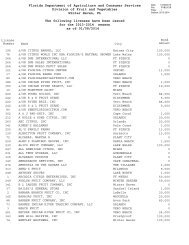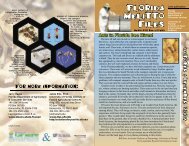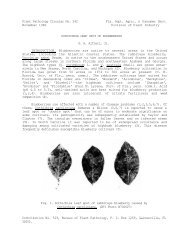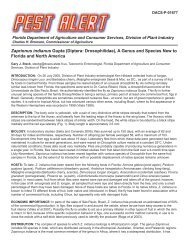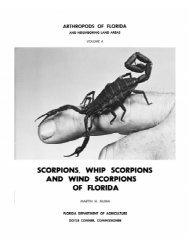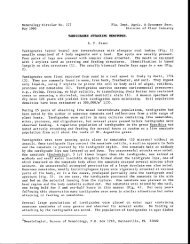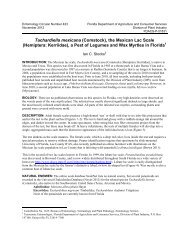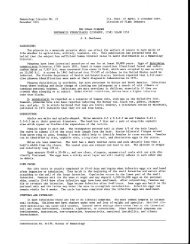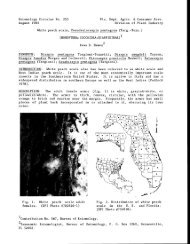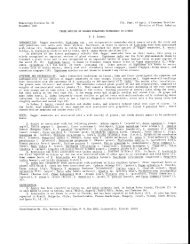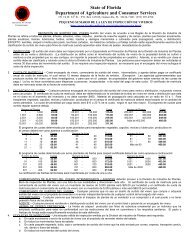A Checklist of the Beetles of Cuba with Data on Distributions and ...
A Checklist of the Beetles of Cuba with Data on Distributions and ...
A Checklist of the Beetles of Cuba with Data on Distributions and ...
You also want an ePaper? Increase the reach of your titles
YUMPU automatically turns print PDFs into web optimized ePapers that Google loves.
2<br />
Arthropods <str<strong>on</strong>g>of</str<strong>on</strong>g> Florida <strong>and</strong> Neighboring L<strong>and</strong> Areas, Vol. 18<br />
The first <str<strong>on</strong>g>Cuba</str<strong>on</strong>g>n nati<strong>on</strong>al park, Parque Naci<strong>on</strong>al<br />
Pico Cristal, was established in 1930, <strong>and</strong> <strong>on</strong>ly five<br />
more had been established by 1959. Then, nine<br />
additi<strong>on</strong>al nati<strong>on</strong>al parks were established under<br />
Public Law 239 in 1959. The first attempt to classify<br />
<strong>and</strong> preserve <str<strong>on</strong>g>the</str<strong>on</strong>g> country’s remaining natural<br />
forests was that <str<strong>on</strong>g>of</str<strong>on</strong>g> Samek (1968). Later, Miller<br />
(1974) provided <str<strong>on</strong>g>the</str<strong>on</strong>g> basis for establishing <str<strong>on</strong>g>the</str<strong>on</strong>g> present<br />
system <str<strong>on</strong>g>of</str<strong>on</strong>g> protected areas. To insure adequate representati<strong>on</strong><br />
<str<strong>on</strong>g>of</str<strong>on</strong>g> all natural l<strong>and</strong>scapes, geographers<br />
<strong>and</strong> biologists evaluated <str<strong>on</strong>g>the</str<strong>on</strong>g>ir protected status.<br />
These efforts resulted in a law establishing a Nati<strong>on</strong>al<br />
System <str<strong>on</strong>g>of</str<strong>on</strong>g> Protected Areas, which now has<br />
more than 200 protected areas that cover 12% <str<strong>on</strong>g>of</str<strong>on</strong>g><br />
<str<strong>on</strong>g>the</str<strong>on</strong>g> country. However, <strong>on</strong>ly 1-2% <str<strong>on</strong>g>of</str<strong>on</strong>g> <str<strong>on</strong>g>the</str<strong>on</strong>g> country is<br />
strictly protected <strong>and</strong> some reserves appear to be<br />
too small to effectively preserve <str<strong>on</strong>g>the</str<strong>on</strong>g> biota <str<strong>on</strong>g>the</str<strong>on</strong>g>y c<strong>on</strong>tain.<br />
It is estimated that <str<strong>on</strong>g>Cuba</str<strong>on</strong>g> now has about two<br />
milli<strong>on</strong> ha <str<strong>on</strong>g>of</str<strong>on</strong>g> forests, <str<strong>on</strong>g>of</str<strong>on</strong>g> which 1.7 milli<strong>on</strong> ha (85%)<br />
c<strong>on</strong>sist <str<strong>on</strong>g>of</str<strong>on</strong>g> natural forests <strong>and</strong> <str<strong>on</strong>g>the</str<strong>on</strong>g> remainder is forestry<br />
plantati<strong>on</strong>s. Of <str<strong>on</strong>g>the</str<strong>on</strong>g>se forested l<strong>and</strong>s, nati<strong>on</strong>al<br />
parks cover 5.1%, wildlife c<strong>on</strong>servati<strong>on</strong> areas are<br />
24.3%, watershed protecti<strong>on</strong> areas are 17.0%,<br />
coastal protecti<strong>on</strong> areas are 18.2%, producti<strong>on</strong> forests<br />
are 32.7%, <strong>and</strong> o<str<strong>on</strong>g>the</str<strong>on</strong>g>r categories are 2.7%<br />
(Santana 1991, Cuevas <strong>and</strong> García 1982).<br />
The purposes <str<strong>on</strong>g>of</str<strong>on</strong>g> this checklist <str<strong>on</strong>g>of</str<strong>on</strong>g> <str<strong>on</strong>g>Cuba</str<strong>on</strong>g>n beetles<br />
are several. It may be used to help evaluate possible<br />
pest status <str<strong>on</strong>g>of</str<strong>on</strong>g> beetles moving into <strong>and</strong> out <str<strong>on</strong>g>of</str<strong>on</strong>g><br />
<str<strong>on</strong>g>Cuba</str<strong>on</strong>g> through human activities. The advantages<br />
<str<strong>on</strong>g>of</str<strong>on</strong>g> this are evident. Some beetles are pests <str<strong>on</strong>g>of</str<strong>on</strong>g> agricultural,<br />
horticultural, <strong>and</strong> forest plants; some are<br />
pests <str<strong>on</strong>g>of</str<strong>on</strong>g> stored agricultural products, or are destructive<br />
to man-made structures; <strong>and</strong> some are actual<br />
or potential vectors <str<strong>on</strong>g>of</str<strong>on</strong>g> diseases <str<strong>on</strong>g>of</str<strong>on</strong>g> livestock, crops,<br />
<strong>and</strong> humans. To unify informati<strong>on</strong> <strong>on</strong> <str<strong>on</strong>g>the</str<strong>on</strong>g>se makes<br />
<str<strong>on</strong>g>the</str<strong>on</strong>g> data more accessible <strong>and</strong> useful to <str<strong>on</strong>g>the</str<strong>on</strong>g> benefit<br />
<str<strong>on</strong>g>of</str<strong>on</strong>g> human society. However, most beetles (as is also<br />
true for almost all insects) have little or no direct<br />
impact <strong>on</strong> human activities. These species comprise<br />
most <str<strong>on</strong>g>of</str<strong>on</strong>g> <str<strong>on</strong>g>the</str<strong>on</strong>g> richness <str<strong>on</strong>g>of</str<strong>on</strong>g> <str<strong>on</strong>g>the</str<strong>on</strong>g> vibrant natural communities<br />
<str<strong>on</strong>g>of</str<strong>on</strong>g> <str<strong>on</strong>g>the</str<strong>on</strong>g> isl<strong>and</strong> <str<strong>on</strong>g>of</str<strong>on</strong>g> <str<strong>on</strong>g>Cuba</str<strong>on</strong>g>.<br />
This list may help to stimulate <strong>and</strong> encourage<br />
additi<strong>on</strong>al research activity in summarizing<br />
biodiversity informati<strong>on</strong> <strong>on</strong> <str<strong>on</strong>g>the</str<strong>on</strong>g> beetles <str<strong>on</strong>g>of</str<strong>on</strong>g> <str<strong>on</strong>g>Cuba</str<strong>on</strong>g>. All<br />
<str<strong>on</strong>g>the</str<strong>on</strong>g> species <str<strong>on</strong>g>of</str<strong>on</strong>g> <str<strong>on</strong>g>Cuba</str<strong>on</strong>g>n insects have been shaped <strong>and</strong><br />
formed by <str<strong>on</strong>g>the</str<strong>on</strong>g> biological <strong>and</strong> physical processes <str<strong>on</strong>g>of</str<strong>on</strong>g><br />
evoluti<strong>on</strong> by natural selecti<strong>on</strong>. The geographic distributi<strong>on</strong>s<br />
<str<strong>on</strong>g>of</str<strong>on</strong>g> <str<strong>on</strong>g>the</str<strong>on</strong>g> species <str<strong>on</strong>g>with</str<strong>on</strong>g>in <strong>and</strong> bey<strong>on</strong>d <str<strong>on</strong>g>Cuba</str<strong>on</strong>g><br />
have been shaped by <str<strong>on</strong>g>the</str<strong>on</strong>g>ir genetic adaptati<strong>on</strong>s to<br />
<str<strong>on</strong>g>the</str<strong>on</strong>g> ecological c<strong>on</strong>diti<strong>on</strong>s <str<strong>on</strong>g>of</str<strong>on</strong>g> <str<strong>on</strong>g>the</str<strong>on</strong>g> local envir<strong>on</strong>ments<br />
<strong>and</strong> physiography, <strong>and</strong> human changes to <str<strong>on</strong>g>the</str<strong>on</strong>g> l<strong>and</strong>scape.<br />
All <str<strong>on</strong>g>of</str<strong>on</strong>g> this is a part <str<strong>on</strong>g>of</str<strong>on</strong>g> <str<strong>on</strong>g>the</str<strong>on</strong>g> patrim<strong>on</strong>y <str<strong>on</strong>g>of</str<strong>on</strong>g> <str<strong>on</strong>g>Cuba</str<strong>on</strong>g>.<br />
The history <str<strong>on</strong>g>of</str<strong>on</strong>g> study <str<strong>on</strong>g>of</str<strong>on</strong>g> insects (<strong>and</strong> especially<br />
<str<strong>on</strong>g>of</str<strong>on</strong>g> beetles) in <str<strong>on</strong>g>Cuba</str<strong>on</strong>g> is l<strong>on</strong>g <strong>and</strong> rich. The science <str<strong>on</strong>g>of</str<strong>on</strong>g><br />
insect tax<strong>on</strong>omy in <str<strong>on</strong>g>Cuba</str<strong>on</strong>g> is <str<strong>on</strong>g>the</str<strong>on</strong>g> most highly developed<br />
<str<strong>on</strong>g>of</str<strong>on</strong>g> any nati<strong>on</strong> in <str<strong>on</strong>g>the</str<strong>on</strong>g> Caribbean. An underst<strong>and</strong>-<br />
ing <str<strong>on</strong>g>of</str<strong>on</strong>g> <str<strong>on</strong>g>the</str<strong>on</strong>g> insect fauna is more advanced for <str<strong>on</strong>g>Cuba</str<strong>on</strong>g><br />
than for any o<str<strong>on</strong>g>the</str<strong>on</strong>g>r isl<strong>and</strong> in <str<strong>on</strong>g>the</str<strong>on</strong>g> Caribbean.<br />
<str<strong>on</strong>g>Cuba</str<strong>on</strong>g> is <str<strong>on</strong>g>the</str<strong>on</strong>g> natural biological <strong>and</strong> cultural<br />
crossroads <str<strong>on</strong>g>of</str<strong>on</strong>g> <str<strong>on</strong>g>the</str<strong>on</strong>g> Caribbean Basin. An underst<strong>and</strong>ing<br />
<str<strong>on</strong>g>of</str<strong>on</strong>g> <str<strong>on</strong>g>the</str<strong>on</strong>g> dynamics <str<strong>on</strong>g>of</str<strong>on</strong>g> insect movement into <strong>and</strong><br />
out <str<strong>on</strong>g>of</str<strong>on</strong>g> <str<strong>on</strong>g>Cuba</str<strong>on</strong>g> over evoluti<strong>on</strong>ary <strong>and</strong> historical time<br />
is important for applied biology <strong>and</strong> management<br />
purposes. Knowledge <str<strong>on</strong>g>of</str<strong>on</strong>g> insect pests is important<br />
for <str<strong>on</strong>g>the</str<strong>on</strong>g>ir c<strong>on</strong>trol. Knowledge <str<strong>on</strong>g>of</str<strong>on</strong>g> insects in general is<br />
an important part <str<strong>on</strong>g>of</str<strong>on</strong>g> <str<strong>on</strong>g>the</str<strong>on</strong>g> cultural heritage <str<strong>on</strong>g>of</str<strong>on</strong>g> all<br />
societies, because all <str<strong>on</strong>g>the</str<strong>on</strong>g>se species are fellow occupants<br />
<str<strong>on</strong>g>of</str<strong>on</strong>g> <str<strong>on</strong>g>the</str<strong>on</strong>g> biosphere.<br />
References<br />
Alayo D., P. <strong>and</strong> Hern<strong>and</strong>ez, L.R. 1987. Atlas<br />
de las mariposas diurnas de <str<strong>on</strong>g>Cuba</str<strong>on</strong>g> (Lepidoptera:<br />
Rhopalocera). Editorial Cientifico-Téchnica, La<br />
Havana, <str<strong>on</strong>g>Cuba</str<strong>on</strong>g>. 148 pp.<br />
Cuevas, J.R. <strong>and</strong> García, F. 1982. Los recursos<br />
naturales y su c<strong>on</strong>servación. Editorial Pueblo<br />
y Educación, La Havana, <str<strong>on</strong>g>Cuba</str<strong>on</strong>g>. 44 pp.<br />
Genaro, J. A. <strong>and</strong> Tejuca, A. E. 1999. Datos<br />
cuantitativos, endemismo y estado actual del<br />
c<strong>on</strong>ocimiento de los insectos cubaños. Cucuyo<br />
8: 24-28.<br />
Holman, J. 1974. Los aphidos de <str<strong>on</strong>g>Cuba</str<strong>on</strong>g>. Instituto<br />
<str<strong>on</strong>g>Cuba</str<strong>on</strong>g>no del Libro, La Havana, <str<strong>on</strong>g>Cuba</str<strong>on</strong>g>.<br />
López Almirall, A. 1998. Algunas characterísticas<br />
del endemismo en la flora de <str<strong>on</strong>g>Cuba</str<strong>on</strong>g> Oriental.<br />
Pp. 47-82. In Halffter, G. (ed.). La diversidad<br />
biológica de Iberoamerica. Vol. 2. Acta Zooogica<br />
Mexicana, nueva series, volumen especial 1998.<br />
Miller, K. 1974. Manejo y desarrollo integral de<br />
las áreas naturales y culturales. Centro de<br />
Investigaci<strong>on</strong>es y Capacitación Forestal, La<br />
Havana, <str<strong>on</strong>g>Cuba</str<strong>on</strong>g>. 102 pp.<br />
Samek, V. 1968. La protección de la naturaleza<br />
en <str<strong>on</strong>g>Cuba</str<strong>on</strong>g>. Serie Transformación de la<br />
Naturaleza. Academia de Ciencias de <str<strong>on</strong>g>Cuba</str<strong>on</strong>g>, La<br />
Havana, <str<strong>on</strong>g>Cuba</str<strong>on</strong>g>. No. 7. 23 pp.<br />
Santana, C.E. 1991. Native c<strong>on</strong>servati<strong>on</strong> <strong>and</strong> sustainable<br />
development in <str<strong>on</strong>g>Cuba</str<strong>on</strong>g>. C<strong>on</strong>servati<strong>on</strong><br />
Biology 5: 13-16.<br />
Smith, E. E. 1954. The forests <str<strong>on</strong>g>of</str<strong>on</strong>g> <str<strong>on</strong>g>Cuba</str<strong>on</strong>g>. Maria<br />
Moors Cabot Foundati<strong>on</strong> Publ. 2, Cambridge<br />
Forest, Petersham, Massachusetts, <strong>and</strong> <str<strong>on</strong>g>the</str<strong>on</strong>g><br />
Atkins Garden <strong>and</strong> Research Laboratory,<br />
Cienfuegos, <str<strong>on</strong>g>Cuba</str<strong>on</strong>g>. 98 pp.<br />
Vales, M. A., M<strong>on</strong>tes, L. <strong>and</strong> Alayo, R. 1998.<br />
Estado del c<strong>on</strong><strong>on</strong>cimiento de la biodiversidad<br />
en <str<strong>on</strong>g>Cuba</str<strong>on</strong>g>. pp. 239-249. In Halffter, G. (ed.). La<br />
Biodiversidad biológica de Iberoamerica. Acta.<br />
Zool. Mexicana,<br />
Woods, C.A. 1989. Biogeography <str<strong>on</strong>g>of</str<strong>on</strong>g> <str<strong>on</strong>g>the</str<strong>on</strong>g> West<br />
Indies: past, present <strong>and</strong> future. S<strong>and</strong>hill Crane<br />
Press, Gainesville, Florida.



